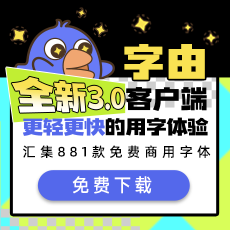| 描述: |
Typeface Family Name: FF DIN.
Library: FontFont Library.
Typeface Designers: Albert-Jan Pool, Achaz Reuss, Antonia Cornelius, Alexei Chekulaev, Alexey Gunin, Panos Haratzopoulos, Yiannis Karlopoulos.
Typeface Design Year: 1995.
Type Style Category: Sans Serif, Grotesque.
Number of Weights: 28.
1994, San Francisco. In a cab ride from the ATypI conference to the airport, Erik Spiekermann recommended to Albert-Jan Pool that he pursue redesigned versions of the OCR and DIN typefaces. He invited Pool to Berlin to discuss the idea in detail. Digital DIN fonts were already available, but limited to two weights with purely geometric construction. They were trending but were generally considered too primitive for professional usage. Spiekermann envisioned that a professional redesign with additional weights, tailored to the needs of communication design, would fill a gap in the market. Pool agreed and with Achaz Reuss (his former URW colleague), Pool designed FF DIN. The family consisted of five weights (light, regular, medium, bold and black) and featured alternate characters, like C and G with diagonal terminals, the round-dot “i”, old-style figures, and arrows. FF DIN was released in 1995 by FontShop International under the FontFont label. The rest is history:
1932, Berlin. The original DIN 1451 typefaces, known as DIN Mittelschrift (medium) and DIN Engschrift (medium condensed) were developed by the German standards body (DIN) for use as a model for public lettering. DIN 1451 was released as a “pre-standard” in 1932, becoming a “regular standard” in 1936. Siemens-engineer Ludwig Goller chaired the committee which did the work on DIN 1451, and while there’s no evidence that Goller actually drew the letters, documents show that he was deeply involved in the development. DIN Mittelschrift and Engschrift have never been available as metal typefaces. Only the Wagner foundry published a mirror imaged version of DIN Mittelschrift in the 1950s. From the 1960s on, DIN typefaces were made available for headline phototypesetting systems such as Bertholds Staromat.
1980, Frankfurt and Berlin. In the late 1970s the German Ministry of Traffic commissioned Adolf Gropp, a lettering artist from Frankfurt, to redraw DIN Mittelschrift and DIN Engschrift. Gropp subtly improved the design, in particular ‘a’, ‘6’ and ‘9’ as well as ‘t’ in DIN Engschrift. For this reason he decided to draw them on a much finer grid. This enabled an exact definition of details such as the amount of overshoot of round characters (e.g. C, G, O and S) below the baseline and above the cap height. Also, characters such as S, for which an accurate construction drawing had never been made, were now defined using lines and arcs. This suited the technical requirements for the new cutting plotters that were to be used for the lettering on high motorway signage. In 1980, the standard DIN 1451 was updated accordingly, Gropp’s drawings replaced the 1932 version. By the mid 1980s, Stempel adopted the redrawn DIN typefaces for Linotype digital photo composition. Adobe released DIN Mittelschrift and DIN Engschrift in 1990 as PostScript fonts, the outlines were based on digitizations by URW.
1995 — 2021, Hamburg, Berlin and elsewhere. Ever since its first release in 1995, FF DIN enjoyed a steadily growing popularity. Having started as a small five-weight-family and being appreciated by a small number of trend-seeking graphic designers, the family soon had to face the demands of ad agencies, international markets and corporate-wide use. First steps were taken in 2000. Assisted by Nicolai Gogoll, Pool added italics, oblique in shape, but optically corrected) and five weights of FF DIN Condensed with the help of Gisela Will. The opening of the iron curtain had led to a growing need for Eastern European characters, these were added in the same year. In 2001, Panos Haratzopoulos (Cannibal Fonts) and Yiannis Karlopoulos added FF DIN Greek. Cyrillic was added in 2005 by Alexei Chekulaev and Alexey Gunin (Double Alex). Vladimir Yevimof (Paratype) supervised the integration into the existing FF DIN family. A few years later, Pool and FontShop decided to extend the family further to suit larger and typographically demanding design projects. In close collaboration with Inka Strotmann (FontShop), Pool designed FF DIN Condensed Italic and FF DIN Round (released in 2011). In 2015 more styles were introduced: two additional weights (Thin and Extra Light, with Italics) for both FF DIN and FF DIN Condensed and support for Vietnamese. Haratzopoulos and Karlopoulos joined the project and supplied Greek character sets for all italic, condensed and condensed italic styles. At the same time, German type designer Jan Germer (aka Yanone) was commissioned to design FF DIN Arabic. In a technique similar to that used in the development of the original DIN, Yanone created a simplified, hand-written Naskh Arabic skeleton on an underlying grid. He methodically refined the shapes to mirror the clarity and legibility of the Latin version. FF DIN Arabic was published in 2016. A few years later, another phase of FF DIN work began: Pool designed FF DIN Slab with Antonia Cornelius (who had studied type design with Jovica Veljovic); Achaz Reuss designed FF DIN Stencil; and Cornelius (advised by Krassen Krestev) added Bulgarian alternates to both FF DIN and FF DIN Slab. Cornelius also painstakingly re-engineered FF DIN’s outlines for Variable font production. At Monotype, the FF DIN families were the first to be produced with Glyphs 3. Monotype’s font engineer Norbert Krausz collaborated closely with Antonia Cornelius and Georg Seifert, chief programmer of Glyphs. Together they made sure that all boundary-pushing issues of the new release were tackled and solved. By 2021, the 28 weights of FF DIN were joined by 28 weights of FF DIN Slab and 14 weights of FF DIN Stencil. All were made available as both static and Variable fonts.
Stories behind the succes: The shape of FF DIN differs from the original mostly with thinner horizontal strokes and more fluent curves. These are optical refinements that enable it to perform better as a text face – both in print and on screen. Regardless of all the improvements, FF DIN kept a clear reference to the simple geometrical look-and-feel of the DIN typefaces as used on the German road signs. Gerard Unger explained the success of FF DIN with the tale of the ugly duckling — even the profane and unsightly may unexpectedly be re-casted and become desirable. The late Dutch typeface designer Evert Bloemsma described FF DIN’s ingredients of its success as follows: 80% hi-tech (cool), 10% imperfection (charming) and 10% ‘mechanics’. Either way, FF DIN has become a phenomenon. The typeface has pervaded corporate and editorial design and found its place in websites, packaging design and ad campaigns and posters of cultural institutions. In 2011, the Museum of Modern Art in New York added the first digital typefaces to its permanent collection. Presumably due in part to the immense popularity enjoyed by FF DIN since its release in the mid-1990s, it was one of 23 designs to be included. FF DIN debuted at MoMA as part of the “Standard Deviations” installation in the contemporary design gallery. Pool considers this as a milestone in the recognition of typeface design as a full member to the family of the applied arts. |








 闽公网安备35010202000240号
闽公网安备35010202000240号